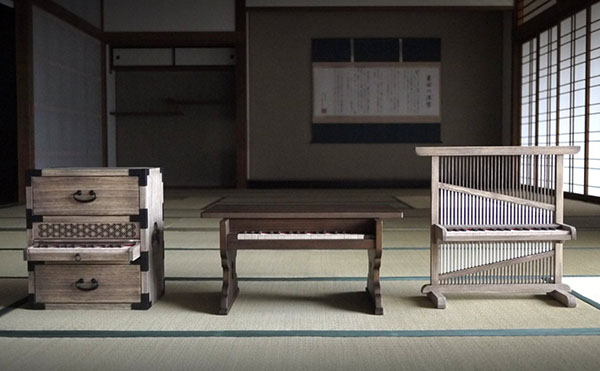What if Japan had Developed the Piano?
Source: Singapore Piano Shop & Music Book Online Shop Published: 9/1/2022 7:39:06 AM Clicked: 1298

What would the piano have looked like if it had evolved independently in Japan?
From the early 1600s until 1853 Japan was closed off from most of the world. This is often referred to as the Edo period. During this time Japan originated its own art, culture, fashion, etc. independent from the thinking of the rest of the world.
The Sumida toy pianos on display - the image shows the instruments placed on a tatami mat
The Sumida Toy Pianos
With the opening up of the country, there was an influx of Western ideas and technologies. The Japanese were also introduced to western music for the first time. Consequently, demand for pianos started to grow, and imported instruments began to appear. And in 1900 the first piano ever to be made in Japan, an upright, was built by Yorakusu Yamaha.
Japan subsequently became one of the main piano manufacturing nations, producing instruments that are generally similar in shape and appearance to those of other manufacturers.
But how would the design of a piano have differed if it had developed in Japan during the Edo period? Cristofori’s first piano appeared around 150 years before Japan opened its doors. Imagine if Japan had known of his work and there had been a demand for such an instrument — how would such pianos look?
The Edo Period
Yamaha Design Laboratory in collaboration with the Department of Design at Chiba University set about answering this question. And the initial results of their work are three beautifully crafted toy pianos.
Yamaha and Chiba University designers took as their reference the lifestyle of residents in downtown Toyko near the Sumida river during the Edo period. Here people lived in close proximity sharing the basics. And ingenuity was a key feature of their lives. People took great pride in being inventive. And it was common to recycle materials for different purposes.
The style of the Edo period was that of straight horizontal and vertical lines and this was reflected in furniture, clothes (kimonos), etc.
The designs the team came up with, based on their research, have been prototyped and are known as the Sumida Toy Pianos.
Hiki-Tansu
two images of the Tiki-Tansu toy piano - one a close-up showing the decoration
This design is based on a traditional chest of drawers (tansu). During the Edo period chests were used extensively, often for storing clothing. Although considered a piece of furniture these chests were rarely seen in the home and mainly used for transporting items – hence the carrying slots in the sides.
This beautifully carved model is 410mm tall and is a working instrument – you can actually play it.
Oto-Tsukue
photo of the Oto-Tsukue piano with the lid retracted to reveal the keyboard
The Oto-Tsukue [sound-desk] piano uses a traditional Japanese writing desk (“fudukue”) as its reference source. This type of desk was commonly found in “terakoya”, which were schools teaching children how to read and write. The lid of the desk slides back to reveal the keyboard, and again this piano is actually playable. It measures 280mm in height.
Sukima
two images showing the Skim toy piano - one a close-up of the decoration
This delicate instrument is inspired by the screens used in old wooden Japanese houses. Sukima means gap or opening. These movable partitions maximised the use of space within a building. Here metal bars, found today in many makes of toy piano, act as the sound source.
This is not a working model. It is 470mm high, and only 220mm deep.
The Hiki-Tansu and Sukima pianos are decorated with the Asanoha motif. This pattern is based on overlapping hexagons and has been used in holy rituals since ancient times. It regularly features as a kimono decoration and is thought to bestow health and longevity.
The Sumida Toy Pianos are on display in Yamaha’s Ginza Shop (Chuo City, Tokyo) from April 29 to May 30 2022.
- Service
- Trade in Pianos
- Move Pianos
- Corporate
- Tune Pianos
- Repair Pianos
- Member
- Career & Jobs
- Area Links


